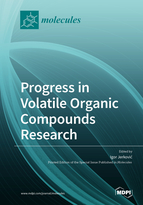Progress in Volatile Organic Compounds Research
A special issue of Molecules (ISSN 1420-3049). This special issue belongs to the section "Natural Products Chemistry".
Deadline for manuscript submissions: closed (31 October 2019) | Viewed by 80462
Special Issue Editor
Interests: volatile organic compounds (terpenes, norisoprenoids, aliphatic and aromatic compounds, others); glycosidically bound volatiles; chemical biomarkers; chemical biodiversity; gas chromatography and mass spectrometry; organic chemistry
Special Issues, Collections and Topics in MDPI journals
Special Issue Information
Dear Colleagues,
Volatile organic compounds (VOCs) have been intensively investigated in last few decades. Their origins could be different: Plant secondary metabolites, food/beverages aroma, fungal/bacterial volatiles, and others. VOCs typically occur as a complex mixture of compounds (e.g., monoterpenes, sesquiterpenes, norisoprenoids, aliphatic/aromatic compounds, sulfur containing compounds, others). They are formed through different biochemical pathways and could be modified or created during drying or maturation, thermal treatment, and others. Different conventional or modern methods of VOCs isolation followed by the analysis with chromatographic and spectroscopic techniques usually provide different chemical profiles and have been under constant modification and upgrading. The ecological interactions are mediated by VOCs (inter- and intra-organismic communication) and they can act as pheromones, attractants or alleochemicals. Among them, chemical biomarkers of botanical origin or chemotaxonomic markers can be found. Many VOCs possess different biological activities, such as antioxidant, antimicrobial, antiviral, anticancer, and others.
There is still great need to research VOCs from different sources, to report their distribution, chemical profiles, and to discover new compounds. This Special Issue aims to attract up-to-date contributions on all aspects of VOCs chemistry (from challenges in their isolation, analysis to synthesis) and on unlocking their biological activities or other useful properties.
Prof. Dr. Igor Jerković
Guest Editor
Manuscript Submission Information
Manuscripts should be submitted online at www.mdpi.com by registering and logging in to this website. Once you are registered, click here to go to the submission form. Manuscripts can be submitted until the deadline. All submissions that pass pre-check are peer-reviewed. Accepted papers will be published continuously in the journal (as soon as accepted) and will be listed together on the special issue website. Research articles, review articles as well as short communications are invited. For planned papers, a title and short abstract (about 100 words) can be sent to the Editorial Office for announcement on this website.
Submitted manuscripts should not have been published previously, nor be under consideration for publication elsewhere (except conference proceedings papers). All manuscripts are thoroughly refereed through a single-blind peer-review process. A guide for authors and other relevant information for submission of manuscripts is available on the Instructions for Authors page. Molecules is an international peer-reviewed open access semimonthly journal published by MDPI.
Please visit the Instructions for Authors page before submitting a manuscript. The Article Processing Charge (APC) for publication in this open access journal is 2700 CHF (Swiss Francs). Submitted papers should be well formatted and use good English. Authors may use MDPI's English editing service prior to publication or during author revisions.
Keywords
- volatile organic compounds
- essential oils
- headspace compounds
- modern methods of volatiles isolation, analysis or synthesis
- chemical or chemotaxonomic biomarkers
- pheromones, attractants, alleochemicals
- biological activity
- GC-MS
Related Special Issue
- Progress in Volatile Organic Compounds Research II in Molecules (10 articles)







